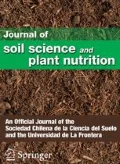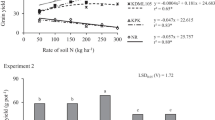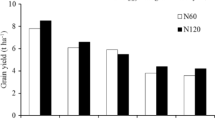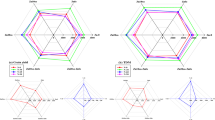Abstract
This study explored the response in grain yield and quality of upland and wetland rice varieties to a combination of zinc (Zn) and nitrogen (N) fertilizers under two water management regimes. A factorial arrangement based on a randomized complete block design composed of three factors was carried out with three independent replications. Upland and wetland rice varieties were grown with three fertilizer treatments; the optimum N rate (86 kg N ha−1) without Zn application, the optimum N rate with Zn (50 kg ZnSO4 ha−1), and the high N rate (172 kg N ha−1) with Zn under waterlogged and well-drained conditions. Grain yield was 27% lower in the well-drained than in the waterlogged condition in wetland rice, while there was no effect in upland rice. Application of optimum N with Zn application produced the highest grain yield in upland rice, while yield was the highest in wetland rice in high N with Zn application. Upland rice grown in the well-drained condition with the optimum and high N with Zn treatments enhanced Zn concentration by 45% and 29% higher than the treatment without Zn, respectively, while it had no difference among three treatments in the waterlogged condition. Wetland rice variety grown under the well-drained condition in optimum and high N rate with Zn treatments were equally effective in improving grain Zn concentration at the average of 88% compared to the control. While rice grown under the waterlogged condition in the high N with Zn treatment had improved 92% the concentration. The optimum N rate with Zn application increased grain yield in upland rice, while the higher N input is required for wetland rice. Grain Zn concentrations of upland and wetland rice varieties were enhanced by applying Zn fertilizer; however, the increased level was depended on N application rate in the individual water condition.




Similar content being viewed by others
References
Alhaj Hamoud Y, Wang Z, Guo X, Shaghaleh H, Sheteiwy M, Chen S, Qiu R, Elbashier MAM (2019) Effect of irrigation regimes and soil texture on the potassium utilization efficiency of rice. Agronomy 9:2–17
Ali H, Hasnain Z, Shahzad A, Sarwar N, Qureshi MK, Khaliq S, Qayyum M (2014) Nitrogen and zinc interaction improves yield and quality of submerged basmati rice (Oryza sativa L.). Not Bot Hort Agrobot Cluj 42:372–379
Alloway BJ (2008) Zinc in soils and crop nutrition, 2nd edn. International Zinc Association and International Fertilizer Industry Association, Brussels, Belgium and Paris, France
Alloway BJ (2009) Soil factors associated with zinc deficiency in crops and humans. Environ Geochem Health 31:537–548
Arif M, Tasneem M, Bashir F, Yaseen G, Anwar A (2017) Evaluation of different levels of potassium and zinc fertilizer on the growth and yield of wheat. Int J Biosen Bioelectron 3:242–246
Beebout S, Goloran J, Rubianes F, Jacob J, Castillo OB (2016) Zn uptake behavior of rice genotypes and its implication on grain Zn biofortification. Sci Rep 6:38301. https://doi.org/10.1038/srep38301
Bremner JM (1960) Determination of nitrogen in soil by the Kjeldahl method. J Agr Sci 55:11–33
Broadley M, Brown P, Cakmak I, Rengel Z, Zhao F (2012) Function of nutrients: micronutrients. In: Marschner P (ed) Marschner’s mineral nutrition of higher plants, 3rd edn. Academic Press, San Diego, pp 191–248
Cakmak I, Kutman UB (2018) Agronomic biofortification of cereals with zinc: a review. Eur J Soil Sci 69:172–180
Chatzistathis T (2014) Zinc deficiency. Micronutrient deficiency in soils and plants. Bentham Science Publishers Ltd, pp 63–87
Datta A, Ullah H, Ferdous Z (2017) Water management in rice. In: Chauhan BS, Jabran K, Mahajan G (eds) Rice production worldwide. Springer International Publishing, Cham, pp 255–277
Dionisio G, Uddin MN, Vincze E (2018) Enrichment and identification of the most abundant zinc binding proteins in developing barley grains by zinc-imac capture and nano LC-MS/MS. Proteomes 6:3. https://doi.org/10.3390/proteomes6010003
Erenoğlu EB, Kutman UB, Ceylan Y, Yildiz B, Cakmak I (2010) Improved nitrogen nutrition enhances root uptake, root-to-shoot translocation and remobilization of zinc ((65)Zn) in wheat. New Phytol 89:438–448
FAO and WHO (2001) Zinc human vitamin and mineral requirements. Food and Agriculture Organization of the United Nations and World Health Organization. Food and Nutrition Division, FAO, Rome
Gao X, Zou C, Fan X, Zhang F, Hoffland E (2006) From flooded to aerobic conditions in rice cultivation: consequences for zinc uptake. Plant Soil 280:41–47
Gonzalez D, Almendros P, Obrador A, Alvarez JM (2019) Zinc application in conjunction with urea as a fertilization strategy for improving both nitrogen use efficiency and the zinc biofortification of barley. J Agric Food Chem 99:4445–4451
Graham R, Senadhira D, Beebe S. Iglesias C. Monasterio I. (1999) Breeding for micronutrient density in edible portions of staple food crops: conventional approaches. Field Crops Res. 60:57-80
Guo JX, Feng XM, Hu XY, Tian GL, Ling N, Wang JH, Shen QR, Guo SW (2015) Effects of soil zinc availability, nitrogen fertilizer rate and zinc fertilizer application method on zinc biofortification of rice. J Agric Sci 154:584–597
Hambidge M (2000) Human zinc deficiency. J Nutr 130:1344–1349
Impa SM, Morete MJ, Ismail AM, Schulin R, Johnson-Beebout SE (2013) Zn uptake, translocation and grain Zn loading in rice (Oryza sativa L.) genotypes selected for Zn deficiency tolerance and high grain Zn. J Exp Bot 64:2739–2751
Jaksomsak P, Rerkasem B, Prom-u-thai C (2017) Responses of grain zinc and nitrogen concentration to nitrogen fertilizer application in rice varieties with high-yielding low-grain zinc and low-yielding high grain zinc concentration. Plant Soil 411:101–109
Kato Y, Katsura K (2014) Rice adaptation to aerobic soils: physiological considerations and implications for agronomy. J Plant Prod Sci 17:1–12
Lindsay WL (1972) Inorganic phase equilibria of micronutrients in soils. In: Mortvedt JJ, Giordano PM, Lindsay WL (ed) Micronutrients in agriculture, pp 41–57
Liu H, Zhao P, Qin S, Nie Z (2018) Chemical fractions and availability of zinc in winter wheat soil in response to nitrogen and zinc combinations. Front Plant Sci 9:1489. https://doi.org/10.3389/fpls.2018.01489
Liu D-Y, Zhang W, Liu Y-M, Chen X-P, Zou C-Q (2020) Soil application of zinc fertilizer increases maize yield by enhancing the kernel number and kernel weight of inferior grains. Front Plant Sci 11:188. https://doi.org/10.3389/fpls.2020.00188
Marschner P, Rengel Z (2012) Nutrient availability in soils. In: Marschner P (ed) Marschner's mineral nutrition of higher plants, 3rd edn. Academic Press, San Diego, pp 315–330
Mongon J, Chaiwong N, Bouain N, Prom-u-thai C, Secco D, Rouached H (2017) Phosphorus and iron deficiencies influences rice shoot growth in an oxygen dependent manner: insight from upland and lowland rice. Int J Mol Sci 18:607. https://doi.org/10.3390/ijms18030607
Pal V, Singh G, Dhaliwal SS (2020) Symbiotic parameters, growth, productivity and profitability of chickpea as influenced by zinc sulphate and urea application. J Soil Sci Plant Nutr 20:738–750
Prasad AS (2014) Zinc: an antioxidant and anti-inflammatory agent: role of zinc in degenerative disorders of aging. J Trace Elem Med Biol 28:364–371
Rice Research Institute (2019) Rice Knowledge Bank. Rice Department, Ministry of Agriculture and Cooperatives, Thailnand. Available via DIALOG. http://www.ricethailand.go.th/Rkb/management/index.php-file=content.php&id=7.htm. Accessed 25 Nov 2019
Saha S, Chakraborty M, Padhan D, Saha B, Murmu S, Batabyal K, Seth A, Hazra GC, Mandal B, Bell RW (2017) Agronomic biofortification of zinc in rice: influence of cultivars and zinc application methods on grain yield and zinc bioavailability. Field Crops Res 210:52–60
Shahane AA, Shivay YS, Kumar D, Prasanna R (2018) Interaction effect of nitrogen, phosphorus, and zinc fertilization on growth, yield, and nutrient contents of aromatic rice varieties. J Plant Nutr 41:2344–2355
Siddique I, Al Mahmud A, Hossain M, Islam M, Gaihre Y, Singh U (2019) Movement and retention of NH4-N in wetland rice soils as affected by urea application methods. J Soil Sci Plant Nutr. https://doi.org/10.1007/s42729-019-00148-2,
Uddin MN, Kaczmarczyk A, Vincze E (2014) Effects of Zn fertilization on hordein transcripts at early developmental stage of barley grain and correlation with increased Zn concentration in the mature grain. PLoS One 9:e108546. https://doi.org/10.1371/journal.pone.0108546
Wade LJ, Amarante ST, Olea A, Harnpichitvitaya D, Naklang K, Wihardjaka A, Sengar SS, Mazid MA, Singh G, McLaren CG (1999) Nutrient requirements in rain-fed lowland rice. Field Crops Res 64:91–107
Wang YY, Wei YY, Dong LX, Lu LL, Feng Y, Zhang J, Pan FS, Yang XE (2014) Improved yield and Zn accumulation for rice grain by Zn fertilization and optimized water management. J Zhejiang Univ Sci B 15:365–374
Xu C-m, Wang D-y, Chen S, L-p C, X-f Z (2013) Effects of aeration on root physiology and nitrogen metabolism in rice. Rice Sci 20:148–153
Zaman NK, Abdullah MY, Othman S, Zaman NK (2018) Growth and physiological performance of aerobic and lowland rice as affected by water stress at selected growth stages. Rice Sci 25:82–93
Acknowledgments
We are grateful to all the staffs at Plant Nutrition Laboratory for glasshouse work and laboratory analysis for their help and support.
Funding
This study was funded by the Thailand Research Fund (RSA6080024) and Chiang Mai University.
Author information
Authors and Affiliations
Contributions
All authors have contributed to the experiment, manuscript preparation, and approved the manuscript.
Corresponding author
Ethics declarations
Conflict of Interest
The authors declare that they have no conflict of interest.
Additional information
Publisher’s note
Springer Nature remains neutral with regard to jurisdictional claims in published maps and institutional affiliations.
Rights and permissions
About this article
Cite this article
Yamuangmorn, S., Rinsinjoy, R., Lordkaew, S. et al. Responses of Grain Yield and Nutrient Content to Combined Zinc and Nitrogen Fertilizer in Upland and Wetland Rice Varieties Grown in Waterlogged and Well-Drained Condition. J Soil Sci Plant Nutr 20, 2112–2122 (2020). https://doi.org/10.1007/s42729-020-00279-x
Received:
Accepted:
Published:
Issue Date:
DOI: https://doi.org/10.1007/s42729-020-00279-x




